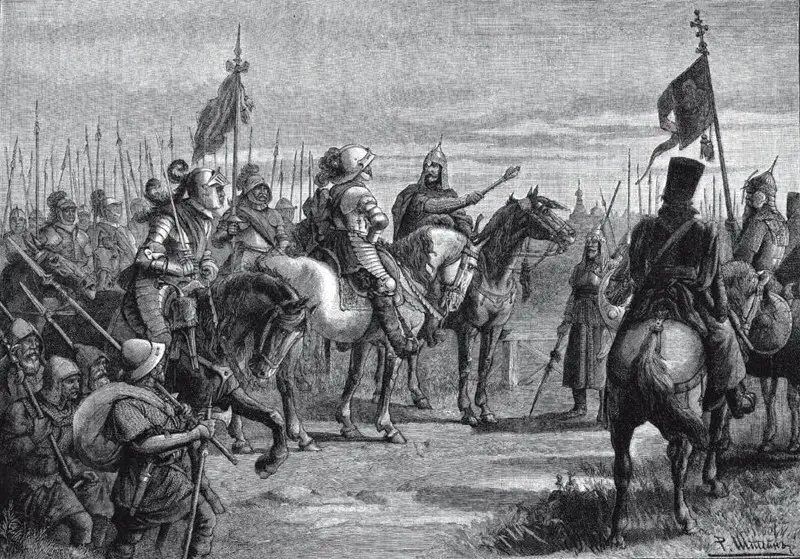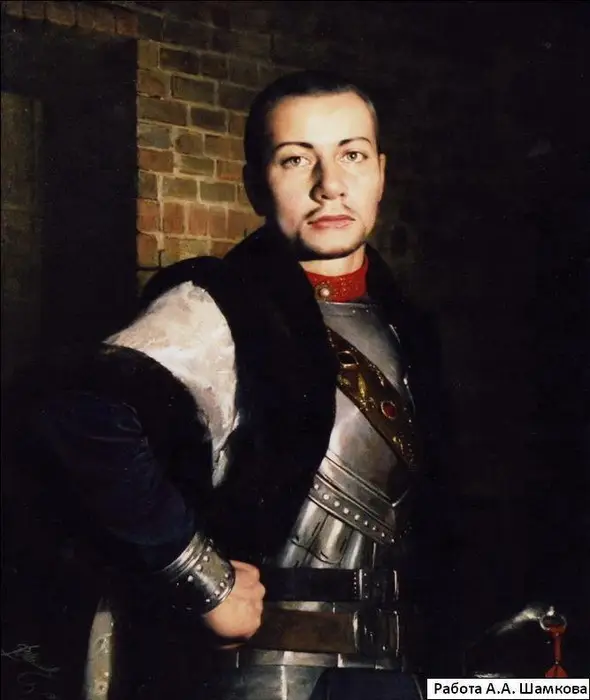Mikhail Skopin-Shuisky: confrontation with the Tushins

Meanwhile, the troops of False Dmitry II, having defeated the Shuisky brothers and other governors who still remained loyal to the tsar, soon besieged the capital. By August 1608, the situation of the besieged was already unbearable; something urgently needed to be done. But how was it possible to defeat the 80-strong army of the impostor stationed near Moscow?
Negotiations with the Swedes
The king did not dare to lead his army outside the city walls, because he was afraid of betrayal, and with defeat he could lose everything. And then the king came up with a more original idea: to send his nephew Mikhail to Vyborg, to the Swedes, so that he would ask the Swedes for military help. With this, Shuisky killed two birds with one stone: firstly, he got rid of a possible contender for the throne, and secondly, if successful, Mikhail would bring with him a considerable foreign army, which should defeat the impostor’s army.

Skopin-Shuisky as imagined by a 21st century artist
The mission entrusted to the 22-year-old prince was not an easy one. It was no small danger to travel from Moscow to Vyborg with just a handful of people, since all the main roads were controlled by strong detachments of Tushins. Further, having arrived in Vyborg at any cost, Skopin-Shuisky was obliged to show all his skill as a diplomat and negotiate with the Swedes to place Swedish troops at his disposal. Then, with this army, Skopin had to defeat the hordes of the impostor and liberate the capital. Therefore, when the prince and his people left Moscow, no one seriously hoped that he would return.
On August 10, 1608, Skopin left Moscow. Since all the roads were controlled by the Tushins, Mikhail and his people, of whom there were no more than 200 people, walked through impenetrable forests. This was not only safer, but also more reliable, because the very fact of the campaign was kept secret from the Tushins.
Arriving in Novgorod less than a month later, Skopin immediately sent an embassy to Vyborg to negotiate with the Swedes. Knowing the terrible situation the Moscow state was in, the Swedes decided to stall for time as long as possible, seeking more favorable conditions for themselves. For the help of a 5-strong detachment, they asked not only for a large sum of money, but also demanded that Korela and the district be ceded to them. Unable to hesitate any longer, Skopin was forced to agree to these conditions.
At this time, the Tushino people finally learned about the negotiations with the Swedes and sent Kernozitsky’s 5-strong detachment to Novgorod. Having learned about this, Skopin did not wait for the Swedes, but began to gather an army of Russian volunteers, preparing to fight back on his own.
But it didn’t come to a battle: believing the reports of local peasants that a huge army was marching to Novgorod, Kernozitsky retreated back on January 11, 1609.
On February 28, an agreement with the Swedes was signed. Only a month later, 5 mercenaries, led by 000-year-old General Pontus Jacob Delagardie, crossed the Russian border. It was impossible to lose another day, many cities had already sworn allegiance to False Dmitry, peasant uprisings were rising all over the country against the impostor, who was now called nothing less than the Tushino thief. Finally, Moscow, which had been under siege for almost a year, could fall at any moment.

Meeting of Skopin-Shuisky and Delagardie
The agreement concluded in Vyborg was extremely beneficial for the Swedish king. He not only received a considerable monetary reward and the Korel fortress, but also in the event of the fall of Shuisky he hoped to lay claim to the Russian throne, and if the Poles prevented this, he hoped to capture the entire Russian North with Novgorod and Pskov.
In other words, the Swedish king was going to conquer Russian lands for Russian money. These were the allies Skopin-Shuisky had to fight with.
Beginning of the campaign
On April 25, the Russian-Swedish vanguard defeated Kernozitsky. On May 5, the main allied forces left Novgorod and set out on a campaign. So far there were no more than 5 Russians in Skopin’s army, and even then they were mostly yesterday’s peasants who still had to be trained. However, now the flow of volunteers to Skopin has increased sharply.
The beginning of the liberation campaign seriously alarmed the commander-in-chief of the troops of False Dmitry II, Hetman Roman Rozhinsky, so he sent a new army under the command of Zborovsky to meet Skopin. The battle with him took place on June 17 near Torzhok. Having suffered defeat, Zborovsky retreated to Tver, where reinforcements and the remnants of Kernozitsky’s defeated detachment approached him. A new battle was coming. Realizing that in case of delay, even greater reinforcements would come to the Poles, Skopin decided to immediately go to Tver.
On July 11, a new battle began near Tver. Polish heavy cavalry, consisting of winged hussars, attacked the troops of Skopin and Delagardie. Skopin's left flank, formed from German and French cavalry, could not withstand the rapid attack and retreated. However, the center and right flank (Swedish and Russian infantry) put up worthy resistance to the enemy.
Despite the fact that it was raining heavily, in which the infantrymen could not use firearms weapon, all attacks of the Polish cavalry were repulsed, and by evening it was forced to return to its original positions. But the result of the battle was not obvious. A day later, July 13, Skopin ordered an attack on the Poles with all his might. A swift attack with all forces soon yielded results: the enemy was defeated and fled in panic behind the fortress walls of Tver. They could not stay there for long and soon fled to Tushino.
After this victory, Skopin faced a new problem. The mercenaries, who were counting on an easy ride in Russia, were unhappy that they had to participate in difficult battles. The reason for the riot was quickly found, because they had not received their salaries for more than a month. Not listening to their commander Delagardi, who begged them to stay, the mercenaries voluntarily left Skopin’s army and headed to Novgorod. Delagardie was forced to run after them to bring them back. Only about 1 Swedes remained with Skopin, led by Christiern Somme, who immediately began training Russian militias.
From that moment on, mercenaries ceased to play a decisive role in the campaign. Now Skopin pinned all his hopes on the Russian militias. Realizing that with the 4–5 thousand soldiers remaining with him, going to liberate Moscow would be suicide, the prince stopped in the small town of Kalyazin, which for a short time turned into a major political center.
Here Skopin continued to gather an army; messengers were sent to all surrounding towns and villages asking for help. 3 professional warriors arrived from distant Smolensk. Help also came in money. The main battle was being prepared, which was supposed to decide the outcome of the war.
Battle of Kalyazin
By mid-August, Skopin’s army already had about 15 people. At this time, Hetman Sapieha had been besieging the Trinity-Sergius Monastery for almost a year. Having learned that his enemy was standing very close, he moved towards Skopin. The battle took place on August 000 near Kalyazin. Having crossed the Zhabnya River, the Sapezhinites immediately attacked the Russian regiments. They soon retreated back, and then ran to the swampy shore of Zhabnya.
Having reached the swamp, as Skopin had intended, the Russians turned left and right. The heavy Polish cavalry pressing from behind did not have time to stop and fell straight into the swamp. A stampede began, and in the meantime the Russians struck from both sides and forced the half-broken cavalry to retreat.
But complete victory was still far away. Knowing that in an open field the Russian infantry would not be able to resist the Polish hussars, Skopin withdrew his troops to a fortified camp and prepared to defend it.
The enemy attack did not take long to arrive. The Sapezhinites continuously rushed to storm the camp for seven hours, but could not take it. In the evening, seeing that the Poles were tired of the hours-long battle, Skopin ordered an attack with all his might. The Sapezhin residents retreated back and then fled. The Russians pursued them, causing great damage.
The victory was complete.

Osprey trampling Polish-Lithuanian banners - monument to Skopin-Shuisky in Kalyazin (2009)
After their accession, the Romanovs, and above all Filaret, did everything to erase the Kalyazin victory from memory. The “forgotten” Kalyazin battle still has this status, since nothing has been done to perpetuate it.
But nevertheless, its significance was great. It was after this battle that widespread popular resistance to the interventionists began, culminating in Pozharsky’s militia.
Also, this victory was able to instill hope in the defenders of Moscow and the Trinity Monastery.
Had Sapega won the Battle of Kalyazin, the Trinity Monastery, in which less than 200 defenders remained, would have fallen, which means Rozhinsky would have been able to completely encircle Moscow and soon take it, since the starving capital would have nothing to hope for...
To be continued ...
Information